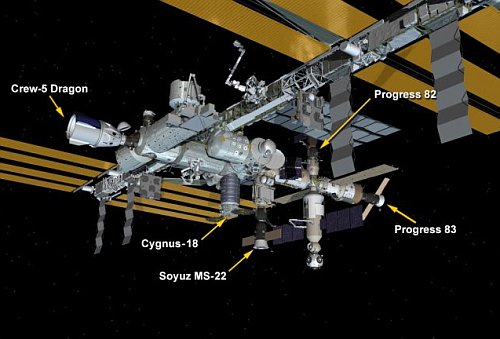
Shortly after a new Progress freighter docked with ISS early today (shown as Progress 83 in the graphic to the right), the older Progress 82 lost internal pressure, possibly in its coolant system.
On February 11, Roskosmos, citing data from mission control, said that the Progress MS-21 cargo ship docked at the station lost pressure. According to the State Corporation, the hatch connecting the ship’s pressurized compartment with the rest of the station was closed and the vehicle was fully isolated from the ISS’ habitable volume.
…According to unofficial sources, the spacecraft lost all its cooling fluid from its Thermal Control System, SOTR. Several hours after the incident, NASA confirmed that the breach had been limited to the cooling system. At the same time, the US space agency said that the hatches between the cargo ship and the station had remained open, while temperatures and pressures aboard the outpost had remained normal. The subsequent publicly available exchange between the NASA mission control in Houston and a US astronaut Frank Rubio, aboard the ISS, indicated that the coolant system of the Progress MS-21 spacecraft had been completely emptied before the leak stopped.
The report is very unclear. In the first paragraph it suggests the freighter’s atmosphere had leaked out, while its hatches were closed and it was isolated from the station. The second paragraph suggests it only lost pressure and coolant from its coolant system, and the hatches had been open during the event.
Either way, this is the second Russian ferry spacecraft to experience such an event since mid-December, when the Soyuz capsule attached to ISS lost its coolant from what is believed to have been a small impact.
This particular Progress freighter is slated to be undocked from ISS on February 18th, when it will be de-orbited, burning up in the atmosphere over the Pacific. Thus, this leak appears to pose a relatively small risk to the station, as it probably has already been filled with station garbage and was likely ready for disposal anyway.
This incident however raises larger concerns. If it was caused by an impact from an external object, either micrometeorite or space junk, it suggests that the station might face a new increased risk of such events, quite possibly from debris from the Russian anti-satellite test in November 2021. As of November 2022 it was estimated that there were 444 objects still in orbit, with all but 18 expected to fall back to earth by 2025. It could be that one of those tracked objects hit ISS, or a different object that has not been tracked.
Or possibly we are seeing evidence of some quality control problem in the construction of these spacecraft, in Russia. Russia and NASA have still not revealed the results of the investigation into the hole that was drilled into the hull of a Soyuz capsule in 2018. Could there be some sabotage going on the ground in Russia that has not been identified that is designed to cause such leaks sometime after launch?
Some clarity on this issue is now becoming essential.










